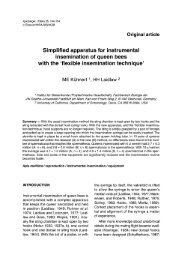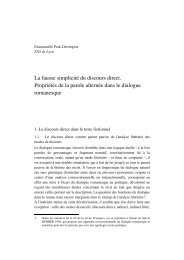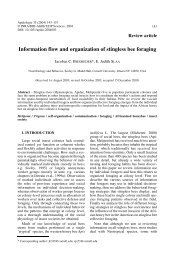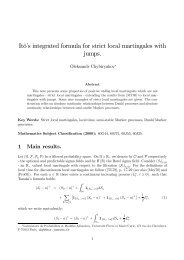ARBEITSGEMEINSCHAFT DER INSTITUTE FÜR ... - HAL - INRIA
ARBEITSGEMEINSCHAFT DER INSTITUTE FÜR ... - HAL - INRIA
ARBEITSGEMEINSCHAFT DER INSTITUTE FÜR ... - HAL - INRIA
You also want an ePaper? Increase the reach of your titles
YUMPU automatically turns print PDFs into web optimized ePapers that Google loves.
zw. 50 °C für 15 Minuten behandelt. Durchschnittlich konnten hierbei im<br />
Vergleich zur Kontrolle nur 23 % bzw. 38 % der Milben abgetötet werden.<br />
Durch die starke Traubenbildung bedingt, können die Bienen scheinbar in<br />
bestimmten Bereichen die Temperatur und/oder die Luftfeuchtigkeit so ändern,<br />
daß der Milben stark reduziert ist.<br />
SUMMARY<br />
The possibilities and limits of thermal treatment<br />
as a biotechnical method of fighting Varroatosis<br />
Experiments utilizing thermal therapy upon artificial swarms were carried<br />
out. An electronically controlled hot air heater was used after its integration into<br />
the hive. Other stores were used for treament. For each temperature 3 small<br />
artificial swarms (ca. 1500 bees) were treated for a maximum of 30 minutes at the<br />
following temperatures : 42, 45, 48, 49, 50 and 51 ° C. The relative humidity<br />
was less than 20 % for all experiments. Until initial bee damage 6 %, 64 %,<br />
86 %, 75 % and 74 % of the mites were killed. At temperatures of 48, 49,<br />
50 and 51 °C initial bee damage occured at times of 20, 15, 11 and 8 minutes.<br />
In order to see whether this test was applicable for field experiments 6 artificial<br />
swarms of normal size (ca. 15000 bees) were treated at 48 °C for 20 minutes and<br />
6 others at 50 ° C for 15 minutes. In comparison to the controls, an average of<br />
only 23 and 38 % of the mites, respectively, could be killed. Apparently bees can<br />
influence the range of temperature and relative humidity by their strong tendency<br />
to build swarms, thereby reducing the mortality of the mites.<br />
RÉSUMÉ<br />
Possibilités et limites du traitement thermique<br />
comme méthode de lutte biotechnique contre la varroase<br />
On a mené des expériences sur l’utilisation du traitement thermique sur des<br />
essaims artificiels. Un radiateur à air chaud et contrôle électronique a été intégré<br />
à la ruche. Des hausses ont été utilisées pour le traitement. On a traité 3 petits<br />
essaims artificiels (environ 1 500 abeilles) pendant 30 minutes maximum pour<br />
chacune des températures suivantes : 42, 45, 48, 49, 50 et 51 °C. L’humidité<br />
relative a été inférieure à 20 % pour toutes les expériences. Il a fallu 20, 15,<br />
11 et 8 minutes respectivement pour noter les premiers dégats causés aux<br />
abeilles aux températures de 48, 49, 50 et 51 ° C. Pour voir si ce test était




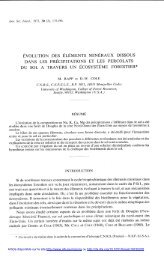
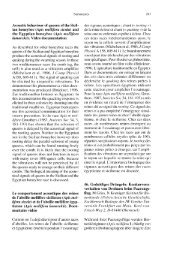
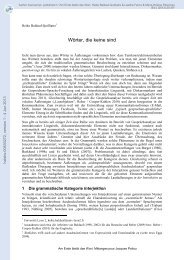
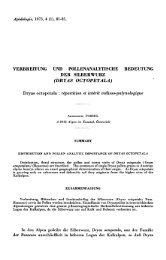
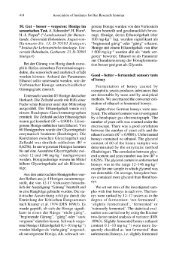
![4 C]-Polyethylenglykol bestimmt, der - HAL - INRIA](https://img.yumpu.com/22454280/1/177x260/4-c-polyethylenglykol-bestimmt-der-hal-inria.jpg?quality=85)
